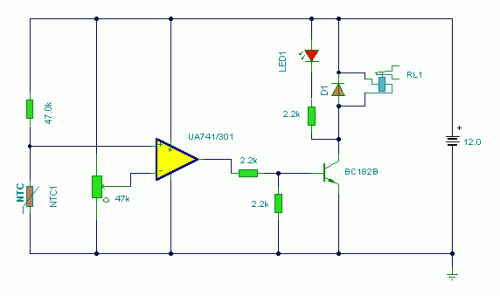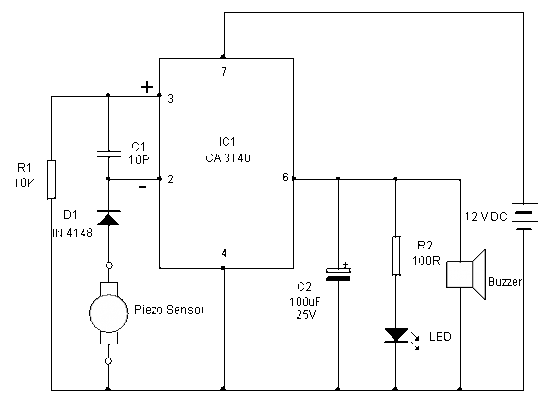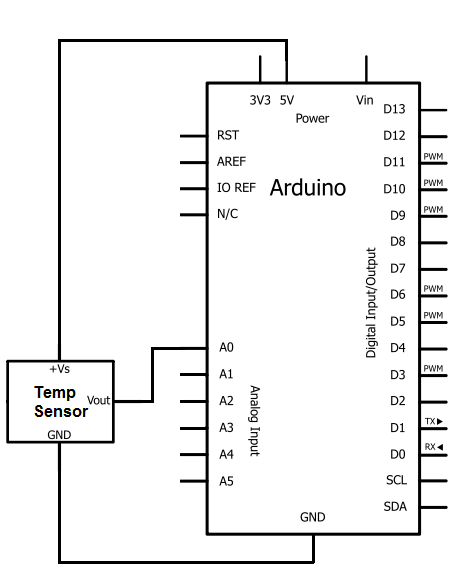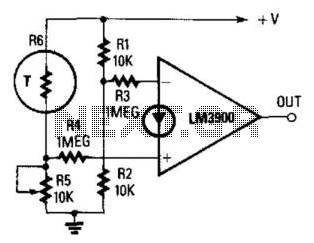
temperature monitor

A thermistor placed in the specified position creates a heat-activated sensor. Variations in temperature will modify the output of the operational amplifier (op-amp), activating the relay and illuminating the LED. Interchanging the positions of the thermistor and the 47k resistor transforms the circuit into a cold or frost alarm.
The circuit employs a thermistor, which is a type of temperature-sensitive resistor, that exhibits a change in resistance with temperature variations. This thermistor is typically a Negative Temperature Coefficient (NTC) type, meaning its resistance decreases as temperature increases. The operational amplifier is configured in a comparator mode, where it compares the voltage across the thermistor with a reference voltage set by the 47k resistor.
When the temperature rises above a predefined threshold, the resistance of the thermistor decreases, causing the voltage at the inverting input of the op-amp to drop below the non-inverting input voltage. This leads to a high output from the op-amp, which energizes the relay. The relay, when activated, can control a larger load, such as a fan or heater, and simultaneously powers an LED to provide visual feedback that the system is active.
Conversely, if the thermistor is swapped with the 47k resistor, the circuit configuration changes to monitor for low temperatures. In this arrangement, as the temperature drops, the resistance of the thermistor increases, causing the voltage at the inverting input to rise above the reference voltage. This output from the op-amp will again trigger the relay, indicating a frost condition.
The relay's contacts can be used to activate an alarm or another device that alerts users to the cold condition. The LED serves as an indicator for both configurations, providing a visual cue for the system's current state, whether it is detecting heat or cold.
This versatile circuit design allows for easy adaptation to various temperature monitoring applications, providing essential functionality in environments where temperature control is critical.Using a thermistor in the position shown makes a heat activated sensor. A change in temperature will alter the output of the opamp and energize the relay and light the LED. Swapping the position of the thermistor and 47k resistor makes a cold or frost alarm.. 🔗 External reference
The circuit employs a thermistor, which is a type of temperature-sensitive resistor, that exhibits a change in resistance with temperature variations. This thermistor is typically a Negative Temperature Coefficient (NTC) type, meaning its resistance decreases as temperature increases. The operational amplifier is configured in a comparator mode, where it compares the voltage across the thermistor with a reference voltage set by the 47k resistor.
When the temperature rises above a predefined threshold, the resistance of the thermistor decreases, causing the voltage at the inverting input of the op-amp to drop below the non-inverting input voltage. This leads to a high output from the op-amp, which energizes the relay. The relay, when activated, can control a larger load, such as a fan or heater, and simultaneously powers an LED to provide visual feedback that the system is active.
Conversely, if the thermistor is swapped with the 47k resistor, the circuit configuration changes to monitor for low temperatures. In this arrangement, as the temperature drops, the resistance of the thermistor increases, causing the voltage at the inverting input to rise above the reference voltage. This output from the op-amp will again trigger the relay, indicating a frost condition.
The relay's contacts can be used to activate an alarm or another device that alerts users to the cold condition. The LED serves as an indicator for both configurations, providing a visual cue for the system's current state, whether it is detecting heat or cold.
This versatile circuit design allows for easy adaptation to various temperature monitoring applications, providing essential functionality in environments where temperature control is critical.Using a thermistor in the position shown makes a heat activated sensor. A change in temperature will alter the output of the opamp and energize the relay and light the LED. Swapping the position of the thermistor and 47k resistor makes a cold or frost alarm.. 🔗 External reference





